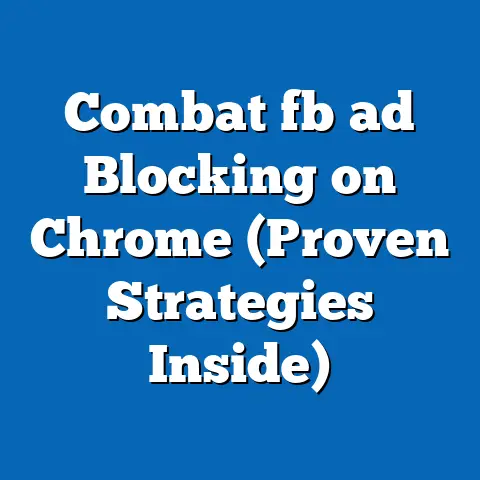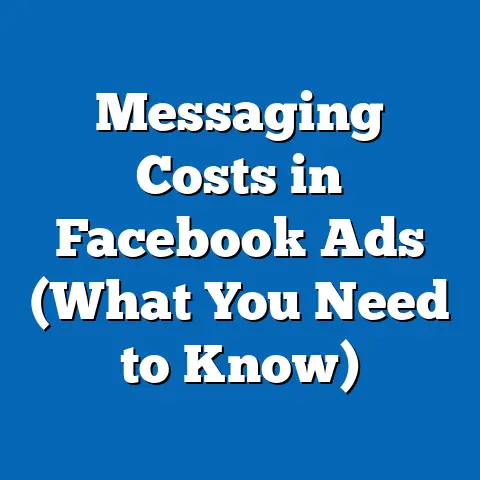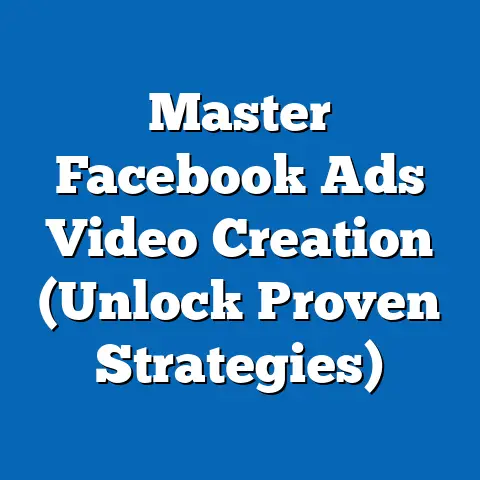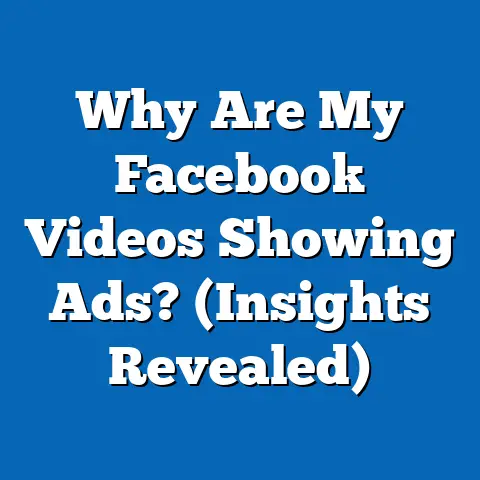Master Targeting Facebook Ads (Proven Strategies Inside)
Have you ever felt like you’re shouting into the void with your Facebook ads? I know I have. You craft what you think is the perfect ad, set a budget, and then… crickets. Or worse, you get clicks, but they don’t turn into customers. This is a common frustration, and honestly, it’s a major reason why so many businesses, both big and small, struggle with Facebook advertising. It’s not just about having a great product or service; it’s about getting that offer in front of the right people.
The problem? Facebook’s advertising platform is a beast. It’s packed with data, options, and algorithms that can feel downright overwhelming. You’re essentially trying to find a needle in a haystack, and if you don’t know what you’re doing, you’ll end up wasting a ton of ad spend on poorly targeted ads that lead to disappointing results and a ridiculously low ROI.
Think about it: according to recent studies, a significant percentage of Facebook ads fail to reach their intended audience. We’re talking about wasted money, missed opportunities, and a lot of frustration. I remember one campaign I ran for a local bakery. I thought I had my targeting dialed in – people interested in baking, local food, desserts. But the results were terrible. It wasn’t until I dug deeper into my audience insights that I realized I was missing a huge segment: people who frequently ordered cakes for birthdays and events. A simple tweak, focusing on that specific behavior, completely turned the campaign around.
That’s why mastering Facebook ad targeting is so crucial. It’s the key to unlocking the platform’s true potential and turning those wasted ad dollars into valuable leads and customers. In this article, I’m going to share some proven strategies that will help you cut through the noise, hone in on your ideal audience, and start seeing the results you deserve.
Understanding Facebook’s Targeting Options
Facebook offers a truly mind-boggling array of targeting options. It’s like having a superpower – the ability to connect with specific people based on their demographics, interests, behaviors, and even their past interactions with your business. But with great power comes great responsibility (and a whole lot of complexity!). Let’s break down the main categories:
-
Demographic Targeting: This is the most basic level of targeting, focusing on characteristics like age, gender, location, education, relationship status, job title, and language. It’s a good starting point, but it’s rarely enough on its own. For example, if you’re selling luxury watches, you might target men aged 35-55 with a college degree and a high income. However, that’s still a pretty broad audience.
-
Interest-Based Targeting: This allows you to reach people based on their hobbies, interests, pages they’ve liked, and topics they follow. This is where things get more interesting. Think about it: if you’re selling hiking gear, you could target people interested in “hiking,” “camping,” “outdoor recreation,” and specific hiking trails or national parks.
-
Behavior-Based Targeting: This is where Facebook’s data prowess really shines. You can target people based on their purchase behavior, device usage, travel habits, and other online activities. For instance, you could target people who frequently purchase organic food online, or those who use a specific type of smartphone.
-
Custom Audiences: This is where you can get really specific and personalize your marketing. Custom Audiences allow you to retarget website visitors, upload email lists of existing customers, or create audiences based on people who have interacted with your Facebook page or Instagram profile. This is incredibly powerful for nurturing leads and driving repeat business.
Demographic Targeting: This is the most basic level of targeting, focusing on characteristics like age, gender, location, education, relationship status, job title, and language. It’s a good starting point, but it’s rarely enough on its own. For example, if you’re selling luxury watches, you might target men aged 35-55 with a college degree and a high income. However, that’s still a pretty broad audience.
Interest-Based Targeting: This allows you to reach people based on their hobbies, interests, pages they’ve liked, and topics they follow. This is where things get more interesting. Think about it: if you’re selling hiking gear, you could target people interested in “hiking,” “camping,” “outdoor recreation,” and specific hiking trails or national parks.
Behavior-Based Targeting: This is where Facebook’s data prowess really shines. You can target people based on their purchase behavior, device usage, travel habits, and other online activities. For instance, you could target people who frequently purchase organic food online, or those who use a specific type of smartphone.
Custom Audiences: This is where you can get really specific and personalize your marketing. Custom Audiences allow you to retarget website visitors, upload email lists of existing customers, or create audiences based on people who have interacted with your Facebook page or Instagram profile. This is incredibly powerful for nurturing leads and driving repeat business.
I remember when I first started using Custom Audiences. I had a small e-commerce store selling handmade jewelry. I uploaded my email list of past customers and created a “lookalike” audience (more on that later). The results were amazing! My conversion rate skyrocketed, and I saw a significant increase in sales. It was like I had suddenly unlocked a secret weapon.
The key is to combine multiple targeting options to create a more refined and relevant audience profile. Don’t just rely on demographic targeting alone. Layer in interests, behaviors, and custom audiences to really narrow down your focus. For example, if you’re selling a vegan protein powder, you could target people interested in “veganism,” “fitness,” and “healthy eating,” who have also purchased similar products online in the past.
Takeaway: Experiment with different targeting combinations to see what works best for your business. Don’t be afraid to get granular and really niche down your audience.
Building Buyer Personas
Think of your ideal customer. What do they look like? What are their goals, their struggles, their dreams? The more you understand your target audience, the better you can tailor your messaging and target your ads effectively. That’s where buyer personas come in.
A buyer persona is a semi-fictional representation of your ideal customer, based on market research, customer feedback, and social media insights. It’s not just about demographics; it’s about understanding their motivations, pain points, and behaviors.
Creating buyer personas is a foundational step in targeting Facebook ads effectively. It helps you:
- Understand your customer’s needs: What are they looking for? What problems are they trying to solve?
- Tailor your messaging: How can you speak to their specific concerns and aspirations?
- Identify the right targeting options: What interests, behaviors, and demographics are most relevant to your ideal customer?
Here’s a framework you can use to create your own buyer personas:
- Demographics: Age, gender, location, income, education, job title, family status.
- Psychographics: Values, beliefs, interests, lifestyle, personality.
- Goals and Motivations: What are they trying to achieve? What motivates them?
- Pain Points and Challenges: What are their biggest frustrations? What obstacles are they facing?
- Buying Behavior: How do they research products and services? What influences their purchasing decisions?
- Social Media Habits: Which platforms do they use? What kind of content do they engage with?
I remember working with a client who was launching a new online course for aspiring entrepreneurs. They had a general idea of who they wanted to target, but they hadn’t really fleshed out their ideal customer. We spent a few hours brainstorming, conducting customer interviews, and analyzing their existing customer data. We ended up creating two distinct buyer personas: “Sarah, the Side Hustler” and “Mark, the Career Changer.”
Sarah was a young professional looking to supplement her income with a side business. She was motivated by financial freedom and creative expression, but she was also worried about the time commitment and the risk of failure. Mark was a mid-career professional looking to make a career change. He was motivated by passion and purpose, but he was also concerned about job security and the learning curve.
By creating these detailed buyer personas, we were able to craft highly targeted ads that resonated with each audience. We used different messaging, visuals, and targeting options for Sarah and Mark, resulting in a significant increase in conversions and a lower cost per acquisition.
Takeaway: Don’t skip the buyer persona step! It’s an investment that will pay off in the long run. The more you understand your ideal customer, the more effective your Facebook ads will be.
Advanced Targeting Strategies
Once you have a solid understanding of Facebook’s targeting options and well-defined buyer personas, you can start exploring some advanced targeting strategies that can really take your ad performance to the next level.
-
Lookalike Audiences: This is one of the most powerful targeting tools on Facebook. It allows you to find new people who are similar to your existing customers. You can create a lookalike audience based on your email list, website visitors, or even people who have interacted with your Facebook page. Facebook uses its algorithms to identify common characteristics among your existing customers and then finds other people who share those characteristics.
I’ve seen incredible results with Lookalike Audiences. I once ran a campaign for a fitness studio, targeting a lookalike audience based on their existing customer email list. The campaign generated a ton of leads and new members, and the cost per acquisition was significantly lower than other targeting methods.
The key to success with Lookalike Audiences is to use a high-quality source audience. The more data Facebook has to work with, the better it can identify the right people.
-
Dynamic Ads: These are personalized ads that show different products or services to each person based on their past behavior. If someone has visited your website and looked at a specific product, you can use Dynamic Ads to show them that product (or similar products) in their Facebook feed.
Dynamic Ads are especially effective for e-commerce businesses. They allow you to re-engage website visitors and drive them back to your site to complete a purchase. I’ve seen clients increase their sales by as much as 30% using Dynamic Ads.
-
A/B Testing Targeting Strategies: Don’t just assume that your initial targeting is perfect. Continuously test different targeting options to see what works best. Try different combinations of demographics, interests, and behaviors. Run A/B tests with different Lookalike Audiences. Experiment with different ad placements.
The key is to track your results and analyze the data. Pay attention to metrics like click-through rate, conversion rate, and cost per acquisition. Use this data to optimize your targeting and improve your ad performance over time.
Lookalike Audiences: This is one of the most powerful targeting tools on Facebook. It allows you to find new people who are similar to your existing customers. You can create a lookalike audience based on your email list, website visitors, or even people who have interacted with your Facebook page. Facebook uses its algorithms to identify common characteristics among your existing customers and then finds other people who share those characteristics.
I’ve seen incredible results with Lookalike Audiences. I once ran a campaign for a fitness studio, targeting a lookalike audience based on their existing customer email list. The campaign generated a ton of leads and new members, and the cost per acquisition was significantly lower than other targeting methods.
The key to success with Lookalike Audiences is to use a high-quality source audience. The more data Facebook has to work with, the better it can identify the right people.
Dynamic Ads: These are personalized ads that show different products or services to each person based on their past behavior. If someone has visited your website and looked at a specific product, you can use Dynamic Ads to show them that product (or similar products) in their Facebook feed.
Dynamic Ads are especially effective for e-commerce businesses. They allow you to re-engage website visitors and drive them back to your site to complete a purchase. I’ve seen clients increase their sales by as much as 30% using Dynamic Ads.
A/B Testing Targeting Strategies: Don’t just assume that your initial targeting is perfect. Continuously test different targeting options to see what works best. Try different combinations of demographics, interests, and behaviors. Run A/B tests with different Lookalike Audiences. Experiment with different ad placements.
The key is to track your results and analyze the data. Pay attention to metrics like click-through rate, conversion rate, and cost per acquisition. Use this data to optimize your targeting and improve your ad performance over time.
I once ran an A/B test for a client who was selling online courses. We tested two different targeting strategies: one based on interests and the other based on behaviors. The interest-based targeting performed well, but the behavior-based targeting blew it out of the water. We discovered that people who had previously purchased online courses were much more likely to convert than people who were simply interested in the topic.
Takeaway: Don’t be afraid to experiment and try new things. The more you test and analyze your targeting strategies, the better you’ll become at finding the right audience for your ads.
Analyzing and Adjusting Targeting Efforts
Facebook advertising isn’t a “set it and forget it” kind of thing. It requires ongoing analysis and adjustment. You need to constantly monitor your ad performance and make changes based on the data.
Here are some key metrics to monitor:
-
Click-Through Rate (CTR): This is the percentage of people who see your ad and click on it. A high CTR indicates that your ad is relevant and engaging to your target audience.
-
Conversion Rate: This is the percentage of people who click on your ad and then take a desired action, such as making a purchase or filling out a form. A high conversion rate indicates that your landing page is effective and that your offer is compelling.
-
Cost Per Acquisition (CPA): This is the amount of money you spend to acquire one customer. A low CPA indicates that your advertising is efficient and cost-effective.
Click-Through Rate (CTR): This is the percentage of people who see your ad and click on it. A high CTR indicates that your ad is relevant and engaging to your target audience.
Conversion Rate: This is the percentage of people who click on your ad and then take a desired action, such as making a purchase or filling out a form. A high conversion rate indicates that your landing page is effective and that your offer is compelling.
Cost Per Acquisition (CPA): This is the amount of money you spend to acquire one customer. A low CPA indicates that your advertising is efficient and cost-effective.
You can use Facebook’s Ads Manager to track these metrics and analyze your ad performance. Pay attention to trends and patterns. Are certain targeting options performing better than others? Are certain ads generating more clicks and conversions?
Based on your analysis, make adjustments to your targeting, your ads, and your landing pages. Try different headlines, visuals, and calls to action. Experiment with different targeting options. Optimize your landing page for conversions.
I’ve seen campaigns completely turn around simply by making small adjustments based on data insights. One time, I was running a campaign for a local restaurant. The campaign was generating a lot of clicks, but the conversion rate was terrible. I analyzed the data and discovered that most of the clicks were coming from people who lived outside of the restaurant’s delivery area. I adjusted the targeting to focus on people who lived within a 5-mile radius of the restaurant, and the conversion rate skyrocketed.
Takeaway: Be flexible and adaptable. Don’t be afraid to pivot your advertising strategies based on data insights. The more you analyze and adjust your targeting efforts, the better your results will be.
Conclusion
Mastering Facebook ad targeting is essential for achieving your business goals. It’s the key to unlocking the platform’s true potential and turning wasted ad dollars into valuable leads and customers.
By understanding Facebook’s targeting options, building detailed buyer personas, and implementing advanced targeting strategies, you can cut through the noise, hone in on your ideal audience, and start seeing the results you deserve.
Remember, successful advertising is an ongoing process of learning and adapting. Continuously monitor your ad performance, analyze the data, and make adjustments based on your insights.
Take action today. Start implementing the strategies discussed in this article, and watch your Facebook ad performance soar. The world of Facebook advertising is constantly evolving, but with the right knowledge and strategies, you can stay ahead of the curve and achieve your business goals.






